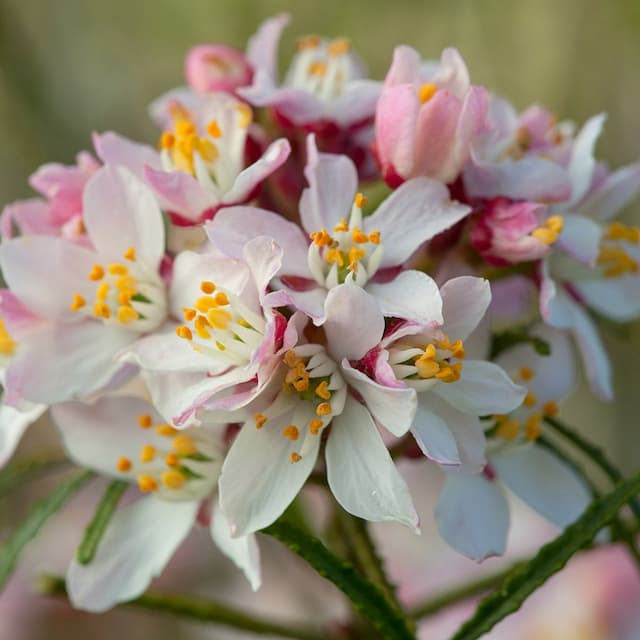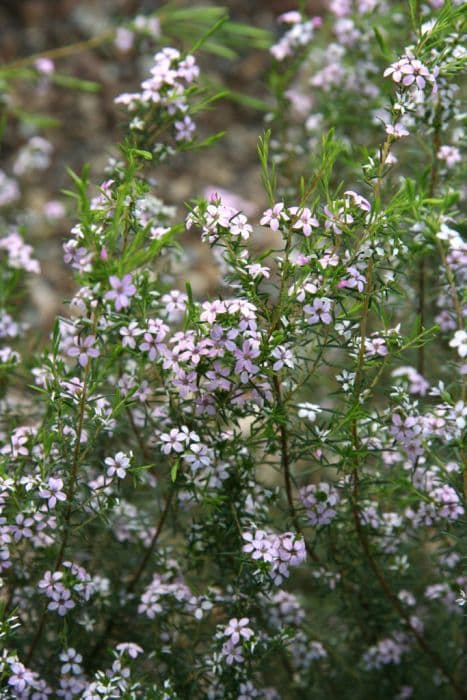Mexican orange Choisya Royal Lace = 'Pmoore06' (PBR)

ABOUT
[Royal Lace] is a variety which has a dense, neat compact habit with slender golden evergreen lacy foliage. White flowers are produced in mounds during the spring.
About this plant
 Names
NamesFamily
Rutaceae
Synonyms
Mexican Orange 'Royal Lace', Choisya 'Royal Lace'
Common names
Choisya ternata 'Pmoore06' (PBR), Choisya 'Pmoore06'
 Characteristics
CharacteristicsLife cycle
Perennials
Foliage type
Evergreen
Color of leaves
Dark Green
Flower color
White
Height
3 feet (0.91 meters)
Spread
3 feet (0.91 meters)
Plant type
Shrub
Hardiness zones
7
Native area
Mexico
Benefits
 General Benefits
General Benefits- Attractive Foliage: Choisya Royal Lace features deeply textured, lacy dark purple to green foliage that adds visual interest to a garden.
- Long Flowering Season: It blossoms in late spring with a profusion of white flowers, bringing seasonal charm.
- Low Maintenance: This plant requires minimal pruning and upkeep, making it ideal for busy gardeners.
- Drought Tolerance: Once established, it's drought-resistant, which is particularly valuable in areas with water usage restrictions.
- Compact Growth Habit: With its moderate growth size, Choisya Royal Lace is ideal for smaller gardens or as part of mixed borders.
- Scented Flowers: The flowers emit a pleasant fragrance that can enhance the sensory appeal of any garden space.
- Pest Resistant: Generally resistant to pests, this plant avoids many of the common garden pests that afflict other shrubs.
- Versatile Planting Options: It can thrive in a variety of soil types and conditions, while also being suitable for container planting.
- Evergreen Nature: As an evergreen shrub, it provides year-round color and structure to a garden.
 Medical Properties
Medical PropertiesThis plant is not used for medical purposes.
 Air-purifying Qualities
Air-purifying QualitiesThis plant is not specifically known for air purifying qualities.
 Other Uses
Other Uses- Choisya Royal Lace can be used as a natural insect repellent due to its strong citrus scent, which is known to deter certain garden pests without the use of chemicals.
- The dense foliage of Choisya Royal Lace offers excellent cover and nesting opportunities for small birds, providing a sanctuary for avian wildlife in your garden.
- Choisya Royal Lace is a suitable plant for creating aromatic wreaths and garlands, as its leaves retain their fragrance when dried.
- The compact and mounded habit of Choisya Royal Lace makes it an ideal plant for topiary or formal edging in garden design, contributing to aesthetically pleasing geometric layouts.
- The plant can be used in sensory gardens due to its textured leaves and aromatic flowers that provide a multisensory experience for visitors.
- Choisya Royal Lace can be harvested for its essential oils, which are occasionally used in homemade perfumery or natural cleaning products.
- When planted along walkways or patios, Choisya Royal Lace can provide a softening effect due to its delicate foliage, enhancing the enjoyment of outdoor living spaces.
- Its vibrant golden-yellow to lime-green foliage can also be utilized in floral arrangements as filler foliage, adding contrast and depth to bouquets and displays.
- As an evergreen plant, Choisya Royal Lace offers year-round greenery for winter gardens, providing color and life during the bleakest months.
- The crushed leaves of Choisya Royal Lace can be used in potpourri mixes for a zesty citrus scent that freshens up the home.
Interesting Facts
 Feng Shui
Feng ShuiThe Mexican Orange Blossom is not used in Feng Shui practice.
 Zodiac Sign Compitability
Zodiac Sign CompitabilityThe Mexican Orange Blossom is not used in astrology practice.
 Plant Symbolism
Plant Symbolism- Beauty and Aesthetics: Choisya Royal Lace, commonly known as Mexican Orange Blossom, symbolizes beauty and aesthetics due to its ornamental foliage and attractive white flowers that bring grace to any garden setting.
- Renewal and New Beginnings: The vibrant green leaves and the plant's tendency to flower in spring align with themes of renewal and new beginnings, reminiscent of the season's symbolism for fresh starts and growth.
- Protection: Often used in landscaping near homes, Mexican Orange Blossoms are thought to symbolize protection, as their dense foliage can create a natural barrier or privacy screen, offering a sense of safeguarding the domestic space.
- Warmth and Cheerfulness: The fragrant flowers and the evergreen nature of the Mexican Orange Blossom represent warmth and cheerfulness, bringing a pleasant and inviting presence to any environment.
 Water
WaterMexican Orange Blossom requires regular watering, especially during dry spells in the growing season. It should be watered deeply once or twice a week, depending on the weather conditions and soil drainage. Provide about 1 gallon of water per plant for each watering session to ensure moisture reaches the roots. During winter, reduce the frequency to match lower temperatures and plant dormancy. Always check the soil moisture before watering; it should be moist but not waterlogged.
 Light
LightMexican Orange Blossom thrives in a bright spot with full sun to partial shade. It prefers at least six hours of sunlight daily but can benefit from some afternoon shade in extremely hot climates. Avoid dense shade since it can result in a leggy plant with fewer flowers.
 Temperature
TemperatureMexican Orange Blossom can tolerate a range of temperatures but performs best between 65°F and 75°F. It can withstand minimum temperatures of around 15°F, though hard frosts may damage the foliage. Avoid locations where temperatures regularly drop below this range or where cold winds can affect the plant.
 Pruning
PruningPrune Mexican Orange Blossom to maintain its shape, remove any damaged or diseased branches, and encourage bushier growth. The best time for pruning is in late spring after the plant has flowered. Lightly trim back the tips of stems and cut back any overgrown areas. Pruning can be done annually or as needed to keep the plant looking tidy.
 Cleaning
CleaningAs needed
 Soil
SoilThe Mexican Orange Blossom 'Royal Lace' prefers well-draining soil rich in organic matter. A good mix would have loam, peat, and coarse sand or perlite to ensure drainage and fertility. Ideal soil pH should be slightly acidic to neutral, around pH 6.0-7.0.
 Repotting
RepottingMexican Orange Blossom 'Royal Lace' should generally be repotted every 2 to 3 years to refresh the soil and accommodate root growth. Spring is the best time to repot to minimize stress on the plant.
 Humidity & Misting
Humidity & MistingMexican Orange Blossom 'Royal Lace' thrives in moderate humidity levels. While it can tolerate some dry air, it performs best with humidity around 50-60%.
 Suitable locations
Suitable locationsIndoor
Place in bright, indirect light and keep soil moderately moist.
Outdoor
Plant in partial shade; shelter from strong winds and frost.
Hardiness zone
7-10 USDA
 Life cycle
Life cycleThe Choisya Royal Lace, also known as Mexican Orange Blossom 'Pmoore06', begins its life as a seed, which, when sown in a well-draining soil mix and exposed to the right conditions, will germinate and produce a small seedling. The seedling stage involves the development of a basic root system and the first true leaves, which will photosynthesize and allow the plant to grow. As it enters the vegetative stage, the plant will establish a more robust root system and produce lush, ornamental foliage that is finely cut and has a delicate, lace-like appearance, and is known for its purple hue. With maturity, the Choisya Royal Lace enters the flowering phase, usually in late spring to early summer, producing fragrant, star-shaped white flowers which attract pollinators. After pollination, if it occurs, the plant may produce small fruit containing seeds, allowing for the continuation of the cycle, although many cultivars are grown from cuttings vs. seeds. Over time, the plant may reach a mature height of around 1 meter, and will then enter a maintenance phase, requiring pruning and care to remain healthy and avoid the senescence stage, in which its growth and vitality may decline.
 Propogation
PropogationPropogation time
Spring-Early Summer
The most popular method of propagation for Choisya 'Royal Lace', commonly known as Mexican Orange, is through semi-hardwood cuttings. This process typically takes place in late summer. A healthy parent plant is selected, and cuttings of about 4 to 6 inches (10 to 15 cm) long with several leaf nodes are taken. The lower leaves are removed, and the base of the cutting is dipped in rooting hormone to encourage root development. Then, the cuttings are planted in a well-draining soil mix, watered thoroughly, and placed in a warm area with indirect sunlight. A plastic cover may be used to maintain humidity around the cuttings, creating a mini greenhouse effect. New growth is usually indicative of successful rooting, after which the new plants can be gradually acclimatized to outdoor conditions before transplanting.









